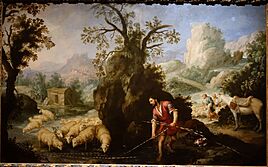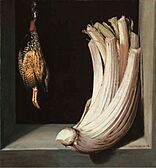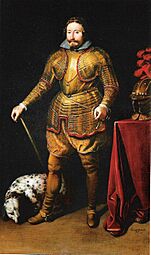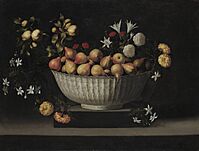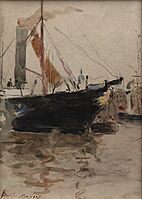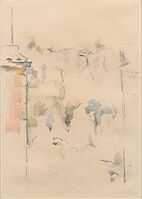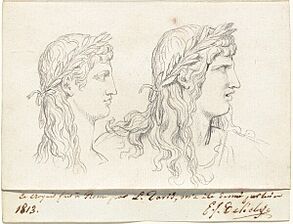William B. Jordan facts for kids
Quick facts for kids
William B. Jordan
|
|
|---|---|
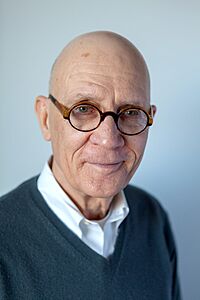
Jordan around 2011–2013
|
|
| Born | May 8, 1940 Nashville, Tennessee, U.S.
|
| Died | January 22, 2018 (aged 77) Dallas, Texas, U.S.
|
| Nationality | American |
| Education | Washington and Lee University (BA) Institute of Fine Arts, New York University (MA, PhD) |
| Occupation | Art historian |
| Years active | 1967–2018 |
| Known for | Art acquisition, attribution, curation |
|
Notable work
|
|
| Spouse(s) | Robert Dean Brownlee |
William Bryan Jordan Jr. (May 8, 1940 – January 22, 2018) was an American art historian. He was known for finding and buying important artworks, organizing art shows, and writing books about Spanish artists and still life paintings, especially from the Golden Age.
Born in Nashville, Tennessee, and raised in San Antonio, Texas, Jordan studied at Washington and Lee University and New York University. In 1967, he became the first director of the Meadows Museum at Southern Methodist University. With help from Algur H. Meadows, Jordan helped the museum get about 75 artworks. He is famous for making the Meadows Museum's collection one of the best Spanish art collections outside of Spain. He also worked at the Dallas Museum of Art.
After leaving the Meadows Museum, Jordan was a top curator at the Kimbell Art Museum from 1981 to 1990. He worked on many still life exhibitions and books, including Spanish Still Life in the Golden Age, 1600–1650 (1985). His 40 years of research on Juan van der Hamen led to his 2005 book, Juan van der Hamen y León & the Court of Madrid. Jordan was on the board of many museums. In 2017, he became an honorary trustee of the Prado Museum in Spain.
Jordan was known for his amazing skill in identifying art, called connoisseurship. He helped museums buy art and figure out who painted certain works. He also had his own private art collection with his husband, Robert Dean Brownlee. In 1988, Jordan bought a painting for £1,000 that he believed was by Diego Velázquez, even though others thought it was by someone else. After it was confirmed to be a Velázquez, he gave the painting, then worth about US$6 million, to the Prado Museum in 2016. After he passed away, many artworks from Jordan and Brownlee's collection were given to different museums.
Contents
Early Life and Education

William Bryan Jordan Jr. was born on May 8, 1940, in Nashville, Tennessee. His parents were Dixie Owen Jordan and William Bryan Jordan. He had three sisters. In 1945, his family moved to San Antonio, Texas. There, he went to Alamo Heights High School. During his summer breaks, he worked at the McNay Art Museum. The museum's first director, John Palmer Leeper, became his mentor and taught him a lot about art.
In 1962, Jordan graduated with honors from Washington and Lee University. He then earned his master's and doctorate degrees in Spanish art history from New York University in 1964 and 1967. For his doctorate, he studied Juan van der Hamen under the guidance of art historian José López-Rey. Jordan spent almost a year in Spain, looking through old records. He found new information about van der Hamen's paintings and life. His 1967 paper, Juan van der Hamen y León, included a detailed list of the painter's works.
Building Art Collections
Leading the Meadows Museum

In 1966, Jordan was offered the job of director at the new Meadows Museum in Dallas, Texas. The museum was having problems because many of its paintings were found to be fake. Jordan visited the museum and realized he would have to "build [the collection] from scratch." Algur H. Meadows, who started the museum, promised over US$1 million to buy new Spanish art. Jordan accepted the job.
Jordan became the first director of the Meadows Museum in 1967. He also became the head of fine arts at the Meadows School of the Arts. The museum closed for a few months while Jordan checked all the artworks. He sold paintings that were not important for a museum and bought new ones. When the museum reopened, its collection included Yard with Lunatics (1794) by Francisco Goya, and works by Francisco de Zurbarán and Bartolomé Esteban Murillo. Jordan wrote about the new additions in an art magazine in 1968.
Jordan also organized art shows. In 1971–72, he put together an exhibition of works related to Dennis Hopper. In 1974, he oversaw Poets of the Cities, a show about modern art. In 1975, Jordan became a full professor at the Meadows School of the Arts. He taught classes on Spanish art history and how to identify art.
From 1977 to 1982, Jordan worked at the Dallas Museum of Art. He organized a show called Dallas Collects in 1978, bringing together 115 artworks from private collections in the city. He also wrote the book for this exhibition.

With Meadows' money, Jordan bought many important artworks at auctions. He greatly expanded the Meadows Museum's collection. This partnership lasted until Meadows died in 1978. During his time, Jordan acquired about 75 artworks. He also helped create the museum's sculpture garden. His purchases included works by Diego Velázquez, Francisco de Zurbarán, Jusepe de Ribera, Murillo, and Pablo Picasso. Jordan is widely praised for making the Meadows Museum's collection one of the best Spanish art collections outside of Spain. He left the museum in 1981 but stayed involved. By 2016, he had given most of his own Spanish paintings to the museum.
Working at the Kimbell Art Museum
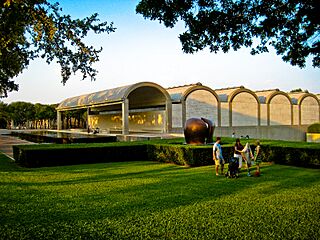
In 1981, Jordan became the deputy director and chief curator of the Kimbell Art Museum in Fort Worth, Texas. He said the museum had not hosted its own art shows before he arrived. He started an "aggressive exhibitions campaign" to grow the collection. In 1982, he organized his first big show there, Jusepe de Ribera, lo Spagnoletto, 1591–1652.
Jordan also helped plan El Greco of Toledo (1982–83). This show had 66 paintings from many countries, making it the largest collection of El Greco's works ever shown. The exhibition traveled to the Prado Museum and the Dallas Museum of Art. Jordan wrote descriptions for the artworks in the show's book.

In 1985, Jordan curated Spanish Still Life in the Golden Age, 1600–1650. This was the first show in the United States to focus on still life paintings. The exhibition and its book were important because they were some of the first scholarly works on this type of art. In 1986, the Spanish government honored Jordan by making him a knight of the Order of Isabella the Catholic. This was for his important work in Spanish art history.
By 1987, Jordan had helped the Kimbell Art Museum acquire over 40 European paintings. He also wrote an essay about the museum's collection. Jordan retired from the Kimbell Art Museum in 1990, when he was 50 years old.
Independent Art Work
After retiring, Jordan worked as a private art dealer to support himself. He focused on writing books and organizing his own art shows. In 1992, he curated The Imitation of Nature: The Still Life of Sánchez Cotán at the Prado Museum. This show included all six known bodegónes (still life paintings of pantry items) by Juan Sánchez Cotán. Jordan wrote the book for this exhibition, discussing Cotán's life and how another artist, Felipe Ramírez, might have copied his work.
Jordan and Peter Cherry organized Spanish Still Life from Velázquez to Goya (1995) at the National Gallery in London. This became the museum's most popular exhibition at the time. The book for the show explained how still life painting developed in Spain.
In 1995, Southern Methodist University gave Jordan an honorary doctorate degree. In 1997, he wrote the book for An Eye on Nature, an exhibition in New York City. This book expanded on his ideas from Spanish Still Life from Velázquez to Goya. When the Nasher Sculpture Center was being planned, Jordan became a board member and a founding director of the Nasher Foundation in 2001.
In 2005, Jordan published Juan van der Hamen y León & the Court of Madrid. This book summarized over 40 years of his research on van der Hamen. Jordan focused on van der Hamen's role in the court of King Philip IV in the 1620s. He showed how versatile van der Hamen was, painting not just still lifes but also portraits and history paintings. Jordan also curated an exhibition about van der Hamen in Madrid and at the Meadows Museum in 2005–06. Art historians liked the book and show, praising Jordan for showing all of van der Hamen's work.
In 2014, Jordan worked with Olivier Meslay at the Dallas Museum of Art. They curated Mind's Eye, an exhibition of over 120 drawings and prints from the 18th to 20th centuries. In 2017, the Prado Museum named Jordan an honorary trustee.
Jordan passed away on January 22, 2018, in Dallas, from a lung illness. He was working on a complete list of van der Hamen's works when he died.
His Special Skills in Art
There's a lot wrong about art now. I mean, so much of the art today is silly. It's hard to find art of very great quality today. But it does exist.
Jordan was an expert on Spanish artists and still life paintings, especially from the Golden Age. He was known for his ability to tell if a painting was real and who painted it. He worked with many museums as an art buying consultant. He also helped identify the artists of many paintings throughout his career.
Finding and Buying Art

In 1976, Jordan saw San Sebastián (1506) by Fernando Yáñez in a gallery in Madrid. At the time, no one knew who painted it, and there were no records to prove it was by Yáñez. But Jordan was sure it was a Yáñez work. He bought it with Meadows' help. Later research proved Jordan was right, and the painting became very important for the Meadows Museum.

In 1979, Jordan helped the Dallas Museum of Art buy Fox in the Snow (1860) by Gustave Courbet. This was outside his usual area of Spanish art. In 1990, the San Diego Museum of Art asked Jordan for his expert opinion when they bought The Adoration of the Shepherds (1572–74) by El Greco and St. Sebastian (1604) by Cotán. St. Sebastian was thought to be by a "Flemish master," but Jordan was the first to say it was a Cotán painting. The museum bought it after Jordan and other experts confirmed his idea.
Identifying Artists
Jordan helped change who was believed to be the artist of some paintings. For example, Still Life with Grapes and Apples (1640) was thought to be by Juan de Espinosa. But Jordan suggested it was by Juan Fernández el Labrador instead. He noticed the painting's soft colors were like Fernández's work, not Espinosa's sharper style. The Prado Museum still says Espinosa painted it, but Jordan's idea was well-received by some art historians.
Jordan also suggested that Pears in a China Bowl (c. 1645) was painted by Juan de Zurbarán, not his father Francisco de Zurbarán. He saw that the painting had similar techniques to Juan de Zurbarán's other works and a different style from his father's. Now, Pears in a China Bowl is known as a work by Juan de Zurbarán.
Jordan also created the term "Pseudo-Hiepes" for an unknown artist. He said about 40 paintings were by this artist because they looked similar to works by Tomás Hiepes. Jordan believed this artist was from Aragon, a region in Spain. His ideas were proven right in 2009 when a signed painting by Bernardo Polo of Aragon was found. Jordan saw that this painting was almost identical to the "Pseudo-Hiepes" works. He concluded that "Pseudo-Hiepes" was actually Polo.
His Own Art Collection
Jordan and his husband Robert Dean Brownlee had a large art collection in their home in Turtle Creek, Dallas.

Jordan's most famous purchase was Portrait of Philip III (1623–31) by Velázquez. He bought it for £1,000 at an auction in London in 1988. The painting was called Portrait of a Gentleman and was thought to be by a follower of another artist. But Jordan believed it was a real Velázquez. He thought it was a study for a larger painting that was later destroyed in a fire.
Jordan noticed that King Philip III's expression and direction in the portrait matched historical descriptions of him in the lost painting. He also saw that the style of the portrait was like Velázquez's other works from that time. Jordan kept the painting in his private collection. In 2015, he sent it to the Prado Museum to be checked. The museum confirmed it was a real Velázquez, and the painting was then valued at about US$6 million. In 2016, Jordan donated it to the Prado Museum.
In 2019, the Dallas Museum of Art received over 80 artworks from Jordan and Brownlee's estate. These included drawings, oil paintings, furniture, and old artifacts. The museum created a special department and an endowment fund from their donations. In 2021–22, the museum held an exhibition called Point, Line, Plane, showing about 50 of these works.
The National Gallery of Art also received many works from Jordan and Brownlee in 2019. These included sketches, prints, and drawings by famous artists like Alberto Giacometti, Cy Twombly, Edgar Degas, and Picasso. In 2020, the Nasher Sculpture Center received sculptures by Claes Oldenburg and Miró from their collection. This included a sculpture called My Father's Watch (For Bill Jordan) which was made using Jordan's father's watch.
Awards and Recognition
- Spain: Knight of the Order of Isabella the Catholic (1986)
- Southern Methodist University: Doctor of Humane Letters (1995)
- Prado Museum: Honorary Trustee (2017)



